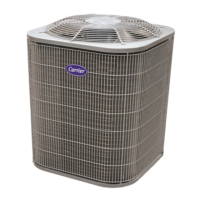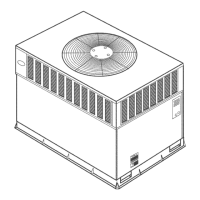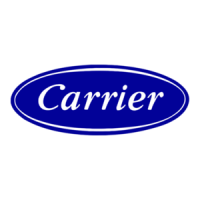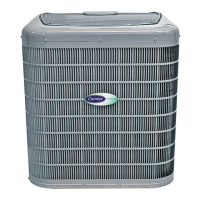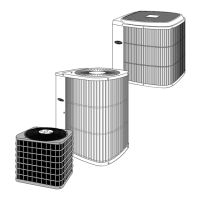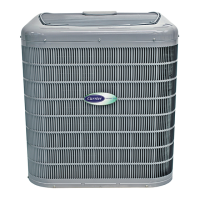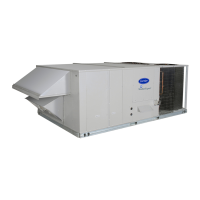24
AUXILIARY HEAT LOCKOUT
The following applies to GC package units with backup electric
resistance heat.
When using the GC communicating units, the “Lock-- out” feature
for electric heat is not enabled on the Infinity/Evolution wall
control. The auxiliary electric heaters will be energized as needed
to maintain system set point. The wall control is “in charge” of the
comfort and the staging. Staging is not to be controlled by a one
time set--up selection or by a temporary manual override. When the
GHP is no longer able to satisfy the thermostat in first or second
stage heating, operation will automatically switch from the GHP to
electric heat, which will remain in operation until the thermostat is
satisfied. Although some customers want control of that
changeover point based on a set outdoor air temperature, this can
negatively affect the comfort and performance of the GHP.
SIf the changeover temperature would be set too high, then the GHP
would not be providing the customer with the best efficiency due
to extended operation (run hours) of the electric heat resulting in
higher energy costs than the customer anticipated.
SIf the changeover temperature would be set too low, then the GHP
would operate in conditions outside its design condition resulting
in poor performance. For example, if the GHP and loop are sized
to provide all the heating requirements down to 15_Fpriorto
auxiliary heat (electric heat operation), then operating the GHP at
outdoor temperatures lower than 15_F would result in continuous
run times, reducing the loop temperature lower than its design
condition. The lower loop temperature then results in lower
capacity for the GHP, causing it to keep running in an attempt to
satisfy th e th ermostat. T he lo op will con tinu e to dro p in
temperature, causing further reduction in capacity and ef ficiency .
This results in a negative “fly wheel” effect that is inescapable
unless auxiliary heat is used or the outdoor temperature increases.
SIn an open loop/well water application where the changeover
temp erature w ou ld b e set too low an d au xiliary heat w as
locked--out, the unit would not be able to maintain the heating set
point and comfort would be compromised.
SThe wall control takes the guesswork out of determining the
change--over set-- point and ensures that comfort and performance
are not compromised.
Emerging From Set--Back
Some key operational features to consider are below:
In set--back (heating) mode:
SWhen coming out of set--back, the system will always first engage
the GHP in first stage heat, then second stage heat, then auxiliary
back--up (electric resistance).
SThe system uses intelligent recovery.
SBack--up heat is not engaged until it has been determined by the
control that second stage heat is not satisfying the thermostat.
If the homeowner manually bumps up the heating setpoint several
degrees:
SThe system will always first engage the GHP in first stage heat,
then seco nd stage h eat, th en au xiliary back -- u p (electric
resistance).
SBack--up heat is not engaged until it has been determined by the
control that second stage heat is not satisfying the thermostat.
SThe duration of this attempt varies based on the rate of temperature
rise and the difference in set --point, but is typically less than 30
minutes. The reason behind this is that the system thinks that if the
homeowner increases the setpoint from, for example 70_ to 74_,
the extra heat is wanted now.
